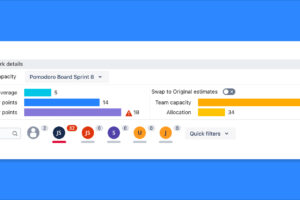Efficiency-Obsessed Workaholics Rejoice: A Guide to Slaying Your To-Do List with the Help of Past Stats and Teammates’ Capacity!
Unleash Your Team’s Superpowers: How Backlog Refinement and Sprint Planning can Boost Productivity (and Save the World)
Backlog refinement is a critical activity for any Agile team as it involves reviewing, prioritizing, and updating the product backlog to ensure that it remains relevant, actionable, and manageable. This process helps the team to have a clear understanding of what they need to build, identify incomplete or unplanned stories, and ensure a solid plan for upcoming sprints. Incomplete or unplanned stories can disrupt a sprint and cause significant delays in product delivery. However, during backlog refinement, the team has the opportunity to identify these stories and make necessary changes. If a user story is not actionable, the team can break it down into smaller, more manageable stories. Alternatively, if a story is no longer relevant or does not align with the product vision, the team can remove it from the backlog. To effectively manage incomplete or unplanned stories during backlog refinement, the following best practices can be implemented: 1. Prioritize stories based on business value and impact to the product vision. 2. Focus on the most important and urgent stories first. 3. Collaborate with stakeholders to ensure that user stories are clearly defined and actionable. 4. Regularly review and update the backlog to ensure that it remains relevant and manageable. In conclusion, backlog refinement is a crucial activity for any Agile team. By effectively managing incomplete or unplanned stories, the team can ensure that they are delivering value to the customer and meeting the product vision. Please note that comments are not required.
From Procrastination to Productivity: How Sprint Planning and Backlog Refinement Can Make Your Team More Efficient (Unless You’d Rather Do Nothing)
Sprint Planning: Why Past Velocities and Team Capacity Matter
Effective sprint planning is crucial to ensuring that Agile teams deliver a valuable product increment at the end of each sprint. This process involves estimating the effort required for each story, selecting the most valuable stories for the upcoming sprint, and determining the team’s capacity to complete the selected stories within the sprint.
Two key factors that contribute to effective sprint planning are past velocities and team capacity.
Past Velocities
- Past velocities measure the team’s productivity in previous sprints and provide valuable insight into the team’s capacity to complete a certain amount of work in a given time frame.
- By analyzing past velocities, Agile teams can estimate how much work they are likely to complete in the upcoming sprint and adjust their sprint backlog accordingly.
- This helps to ensure that the team is not overcommitting or undercommitting and is able to deliver a valuable product increment at the end of the sprint.
Team Capacity
- Team capacity is an estimate of the amount of work that the team can complete in a given sprint.
- Factors that may impact team capacity include team size, individual team member availability, and external factors such as holidays or training.
- By taking into account team capacity during sprint planning, Agile teams can ensure that they select the right amount of work for the upcoming sprint and that team members are not overburdened or underutilized.
By considering both past velocities and team capacity during sprint planning, Agile teams can ensure that they select the right amount of work for the upcoming sprint and deliver a valuable product increment at the end of each sprint.
The Ultimate Guide to Sprint Planning: How Subtasks in Your Backlog Can Make or Break Your Team’s Productivity (Hint: Past Velocity and Capacity May Save You).
The Role of Subtasks in Sprints and Backlog Management
Subtasks play a crucial role in breaking down larger user stories or tasks into smaller, more manageable components. They help teams to track progress and ensure that all necessary work is completed within a sprint. Subtasks can be created during sprint planning or backlog refinement sessions, and are also helpful when estimating the effort required to complete a task.
Best Practices for Creating Subtasks
- Ensure that each subtask is small enough to be completed within a day or two.
- Phrase subtasks as action items or tasks that have a clear outcome or deliverable.
- Assign subtasks to specific team members to ensure accountability and ownership.
Best Practices for Assigning and Tracking Subtasks
- Assign subtasks to team members with the required skills and knowledge to complete them.
- Ensure that all team members are aware of their assigned subtasks and any dependencies between them.
- Track subtask progress by updating the status regularly and identifying any roadblocks or obstacles.
- Ensure that all subtasks are completed by the end of the sprint.
In conclusion, subtasks are a powerful tool for managing sprints and backlogs. By breaking down larger tasks into smaller subtasks, teams can ensure that all work required to complete a user story is completed within a sprint, and progress is tracked effectively. Following best practices for creating, assigning, and tracking subtasks can help to optimize team productivity and ensure that sprint goals are met.
Finally Get Some Work Done: A Guide to Pretending You Have a Clue About Backlog Refinement and Sprint Planning by Abusing Your Team’s Capacity and Ignoring Past Mistakes
In conclusion, effective management of backlog refinement and sprint planning is crucial for the success of any Agile project. Project managers who prioritize these tasks, consider past velocities, and utilize subtasks will be better equipped to meet project deadlines, manage resources efficiently, and deliver high-quality work. By following the best practices outlined in this article, project teams can achieve a more streamlined and productive workflow that leads to successful project delivery. Please let me know if you need any further assistance.





